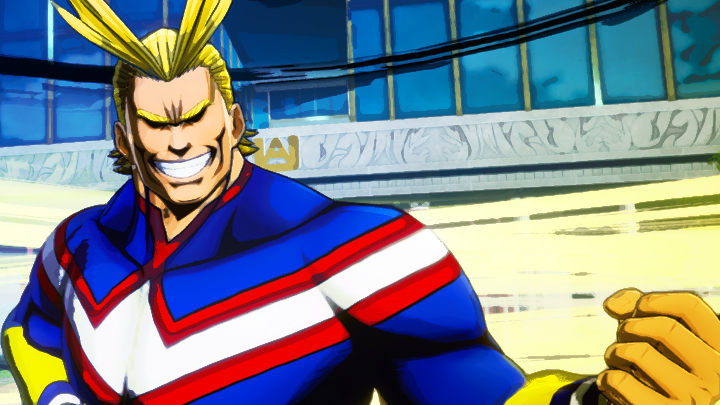Thanks to Bandai Namco for sending us a review copy. Based on the popular manga and anime, My Hero Academia, is One’s Justice a game for one or a game for all? Let’s find out.
Story
In this world, nearly everyone has superpowers known as “quirks”. When our hero, Izuku, heads to Hosu City for further training, he finds his classmate Iida taking on the dreaded Hero-Killer, Stain. Stain is part of a larger group of villains headed by All for One who plans on taking over Hosu City. For fans, the story mode covers the second season of the anime. For people new to the series like myself, there’s not enough time to get to know all of these characters. The story isn’t anything special, but it’s serviceable and gives you an idea of who some of these characters are.
Gameplay
One’s Justice is a 3D arena fighting game, similar to other anime-based fighting games. Although it has fewer combos than a Naruto or Dragon Ball game to make it more simple. You have your standard attack button, quirk attacks, block, dash, two support character attacks, plus ultras (super moves), grabs, counter attacks and unstoppable attacks (which are sometimes grabs). Despite the name, the unstoppable attacks could be stopped and I didn’t find useful in most cases. Blocking can only be done on the ground and a lot of the time I was in the air so that wasn’t great either. However, counter attacks I think are cool and very useful. To perform it, press the standard attack in a direction. The move has super armour, meaning you will still take damage, but be able to finish your attack. But there is a catch. It takes a few seconds for the attack to land, which allows your opponent to use theirs and counter your counter-attack. It gives the player being pummeled a chance to retaliate, but it’s also not an attack you can’t escape from. Fighting in the air is quite common and while things can get hectic, I never felt like I lost sight of my opponent. The camera is locked onto them, and dashing in the air will send you towards them.
One of the big draws to My Hero Academia is that everyone has a unique… quirk (boo!). In this game, quirks act as two separate special attacks. Most of the time there’s a secondary version of these attacks if you push in a direction at the same time. There are also certain conditions which you can and can’t use them in, listed in your moves list. Overall, the characters are great and each has a distinct trait to separate them from the rest. For example, Shota Aizawa can pull you in from a distance quickly to set up a combo. Himiko Toga can transform into the opponent for a limited time. Momo Yaoyorozu can change her weapon. Shoto Todoroki can freeze opponents with an ice attack. And Izuku Midoriya has close and long-range attacks that can be charged. The game has two different types of control configurations, normal mode (the default) and manual. Normal allows you to perform combos with quirks, by only using the standard attack button. The game isn’t that difficult so I didn’t bother using it, but it’s there if you want it.
Aside from online and offline multiplayer, One’s Justice has a lot to offer in terms of modes and content. There are three single-player modes: story, arcade, and missions. Story is the main mode that gets you familiar with heroes and villains movesets. They consist of one round fights (sometimes with support characters) through an overarching narrative and last around seven hours. Arcade mode lets you choose one character (and two supports) in a series of six matches. The person who wins the best two-out-of-three rounds wins the match. In between matches character exchange dialogue, some of which is tailored to the specific matchup. Lastly, mission mode is another series of one round fights, but matches come with varying conditions, and your health will be carried over to each match.
Even if you’re playing by yourself there’s plenty to do and they all have their purpose. Story mode lets you try all of the characters in a safe environment. Arcade gives you more room to grow with the characters you like playing. And mission mode puts a twist on normal fights.
Through these various modes, you can unlock or buy a lot of content such as costumes, art for your online profile, poses, voice clips, accessories and more. Accessories can mostly be exchanged between characters to create whatever weird hodgepodge, fan-fiction character you want. Go nuts! Each character has both their hero costume and school uniform in various colours to collect.
Presentation
The animated manga panels in the story mode liven up what could have been basic support conversations. The overall aesthetic of the menus and characters are rich with color and look great. Little touches like characters covering their ears when Jiro blasts a soundwave are nice too. Fighting on walls and destructible environments make the stages more interesting as well. Even if destruction is only a visual effect and not a gameplay mechanic.
Verdict
My Hero One’s Justice is a solid fighting game. While it’s not as deep as the others, it doesn’t need to be. Each character has a distinct trait that changes their play style to still make them interesting. There’s a good amount of single-player content to play, and tons of collectibles for those who like customization.

- My Hero One’s Justice (PS4) Review - November 18, 2018
- Smash Ultimate: Final Character Impressions - November 10, 2018
- Features Cut from the Smash Bros. Series - November 7, 2018








